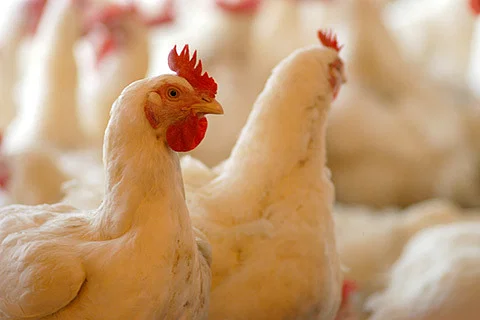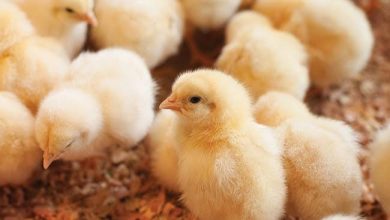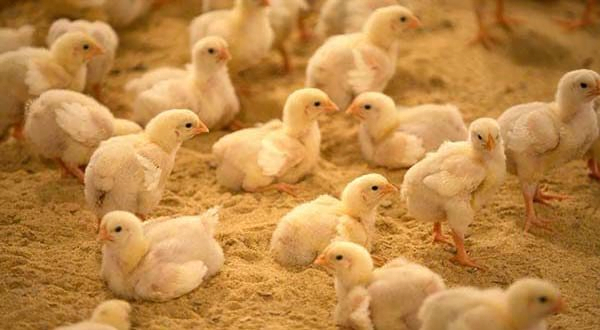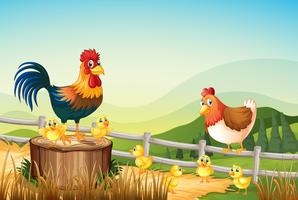Natural Aromatic Herbal Plants For Enhancing Poultry Health And Performance

Natural Aromatic Herbal Plants For Enhancing Poultry Health And Performance
Ruokuobeinuo Huozha2*, Aarti Adhikari1, Swati Thakur2, Mayank Patel2 Brijesh Kumar2
College of Veterinary and Animal Sciences, G. B. Pant University of Agriculture & Technology, Pantnagar-263145 (U. S. Nagar), Uttarakhand, INDIA
Poultry industry is contributing immensely in broiler meat and eggs production around the world. Poultry sector is expanding faster than any other livestock’s industry. In due production, antibiotics have been widely used but a great concerned raised because of its residual effects in the tissues, induction of bacterial resistance, environmental and health hazards such as emergence of drug-resistant organisms. Recently several herbal bioactive compounds, plant products and phytogenic compounds were identified and used for promoting poultry performance and against pathogen resistance organisms. The composition and concentrations of these bioactive constitutes may vary according to their natural habitat, further processing and storage conditions. Used of aromatic herbal plants in poultry feed is gaining popularity due to its beneficial effects on gut health, immunity booster, growth performance, stimulant for digestive enzymes secretion and ultimately enhance production with none or lesser side effects.
Rosemary (Rosmarinus officinalis):
Rosemary or “Gulmehendi” is a perennial shrub in the mint family Lamiaceae. Mediterranian region is the native home of this herb, since then cultivated around the world. Rosemary plant is loaded with phenolic acids (carnosic acid, carnosol, rosmarinic acid) and essential oils (camphor (5.0–21%), 1,8-cineole (15–55%), α-pinene (9.0–26%), borneol (1.5–5.0%), camphene (2.5–12%), β-pinene (2.0–9.0%) and limonene (1.5–5.0%)). Rosmarinic acid has antibacterial, antiviral, antioxidant, anti-inflammatory, antimicrobial, anti-allergic, and anti-diabetic effects. Fresh leaves or leaves powder of rosemary herb added into poultry feed improves liver health especially against aflatoxicosis and at low levels it acts as growth promoter in broilers.
Dill (Anethum graveolens):
Dill is an annual or biennial annual herb in the family Apiaceae. This herb is native to Eurasia and Mediterranean region, but now widely grown around the world. Active components in Dill are carvone and rich vitamin C. It is widely used in Indian medicines due to its digestive, carminative, stomachic, galactogogue, tranquilizing, antimicrobial, insecticidal, antifungal, anti-inflammatory and analgesic properties. Dietary supplementation of Dill leaves powder to poultry, produced anti-stress effect, increase feed intake, keeping gut healthy and growth promoter. Dill is considered a good herbal antibiotic for enhancing broiler production.
Mint or Mentha:
Mint or mentha belong to the family Lamiaceae same with peppermint and spearmint. Mint has rich minerals (K, Mg, Ca, P, Fe) and vitamins (A, C). Rosmarinic acid contain in mint has antioxidant, anti-inflammatory and anti-allergenic properties, and menthol works as excellent aromatic decongestant.
Peppermint (Mentha piperita):
Peppermint is an aromatic plant, a cross between water mint and spearmint. It originate from Europe and is cultivated all over the world. It is effective for alleviating muscle and nerve pain, indigestion, and gut related issues. Peppermint contains menthol (38.45%), menthone (21.8%), 1,8-cineole (5.62%), neo-menthol (4.19%) and 0.2% carvone which acts as effective decongestant, expectorant, antimicrobial against antibiotic-resistant bacteria strain and promoted fibroblasts growth. Either in dried or fresh peppermint leaves supplemented into poultry layers improves egg quality, hatchability and efficient egg production but it promote growth in broiler.
Spearmint (mentha spicata):
Spearmint is a pleasant-smelling herb in the mint family, sweeter taste than peppermint is called “Pudina” in India. Like peppermint, it alleviates digestive symptoms, nausea, headache, sore throat, pain relief, fatigue and stress. It contains about 70% carvone which is rich in limonene, dihydrocarvone and cineol, only about 1% menthol and phytonutrients. It is known for antifungal and antioxidants properties. Spearmint enhance feed intake and growth due to its natural flavoring agent.
Marjoram (Origanum majorana):
Marjoram or sweet marjoram is a perennial herb plant in the mint family Lamiaceae. It originates from eastern part of Mediterranean region and Western Asia. Marjoram main components are terpinene and terpineol, and others including cryptoxanthin, lutein, zeaxanthin and rich beta-carotene, vitamins (A, K) and minerals (Cu, Fe, Mn, Mg). Marjoram flowers, leaves and oil extract are commonly used for treating many ailments due to its anti-inflammatory, antimicrobial, antibacterial, hepatoprotective and antioxidant properties. Marjoram dried powder as feed supplement to laying hens, it functions as antibacterial agent against harmful bacteria. Together marjoram powder and extract incorporated into broilers feed acts as effective growth promoter and improve overall productive performance.
Thyme (Thymus vulgaris):
Thyme or ‘Banajwain’ is a dwarf, pungent herb in the mint family Lamiaceae. This herb is natural habitat to southern Europe but is cultivated throughout the world. The main bioactive components are thymol (48.1%), p-cymene (11.7%), 1,8-cineole (6.7), γ-terpinene (6.1%) and carvacrol (5.5%). Thyme has anti-bacterial, anti-fungal, antitussive, antibroncholitic, anti-inflammatory, antioxidants and antibiotics properties. Thyme used as natural feed additive in poultry feed, enhance immunity, digestive stimulant, and maintain intestinal barrier integrity by antioxidant, anti-parasitic and antibiotics effects.
Oregano (Origanum vulgare):
Oregano is an aromatic perennial herb plant in the family Lamiaceae. This herb plant native to the Mediterranean region and widely naturalised elsewhere in the temperate Northern Hemisphere. Its key bioactive components are thymol and carvacrol, and rich vitamin K1. It also contains small quantities of other vitamins (A, C, E, B6, folate) and minerals (Ca, Fe, K, Mg, Mn). Oregano has powerful antibacterial, anti-fungal, anti-inflammation, antioxidants, immunity booster and anti-diabetic properties. Oregano supplemented to poultry layer improves immunity, nutrient absorption and egg production due to its natural antibiotic, effective antibacterial and coccidiostat effects.
Basil (Ocimum basilicum):
Basil or sweet basil is an annual herb in the family Lamiaceae. Natural habitat to tropical Asia and widely known as classic culinary herb. It contains polyphenols, phenolics, flavonoids, terpenoids, alkaloids, tannins, saponin, glycosides, and phytonutrients of protein, vitamins (C, K), minerals (Fe). Fresh leaves contains phytochemicals in majority as methyl cinnamate (70.1%), linalool (17.5%), β-elemene (2.6%) and camphor (1.52%). This contributes a wide properties of anti-cancer, radioprotective, anti-microbial, anti-inflammatory, immunomodulatory, anti-stress, anti-diabetic, anti-pyretic, anti-arthritic, anti-edematogenic and antioxidant. Supplementation of basil leave to poultry layers and broilers increases feed consumption and nutrient utilization. Hence, it improves egg quality and growth by supporting immunity and anti-stress during summer season.
Pineapple Sage (Salvia elegans):
Pineapple Sage is a frost-tender herbaceous perennial, smell fruity like pineapple and slightly musky sage in the family Lamiaceae. It is naturally grown in Mexico, Guatemala, and mostly in colder regions. Pineapple sage contains high phytonutrients of vitamins (rich K, good source of A, C, E, B6, folate), minerals (Mn, Zn, Cu) and dietary fibres. It has several properties of anti-depressant, anti-inflammatory, anti-anxiety, antihypertensive, antimicrobial, antifungal, antibacterial and antioxidant. Supplementation of Pineapple sage extract to poultry layers is effective against Salmonella infections.
Catnip (Nepeta cataria):
Catnip, catswort, catwort and catmint is a short-lived perennial herbaceous plant in the family Lamiaceae. It is native to Europe and Asia regions. Catnip produces a chemical called Nepeta lactones, a terpene which is thought to mimic feline sex pheromones and natural insect repellents. Catnip contain rich antioxidant of flavonoids, phenolic acids (caffeic acid, rosmarinic acid), Iridoids, tannins, volatile oil (mainly alpha- and beta-nepetalactone, citronellol, geraniol, thymol, pinene), vitamins (C, E) and minerals (Cr, Fe, Mn, K, Se, Co). Catnip keeps the laying environment free from insects and essentially keep the reproductive healthy.
Lavender (Lavandula angustifolia):
Lavender is a strong-scented perennial flowering plant in the family Lamiaceae. This herbs naturally grown in Mediterranean, Middle East and some parts of India. It contains essential oils monoterpenes, flavonoids, linalool, linalyl acetate, vitamins (A, C) and minerals (Ca, Mg, Fe). Lavender has properties of anti-bacterial, anti-fungal, antiseptic, antioxidants, anti-inflammatory, antimicrobial and sex-hormone like effects. Essential oil of Lavender in broiler feed, it promote growth by controlling the gut microbiota, intestinal morphology and perform antibacterial and antioxidant effects. Lavender increases blood circulation in laying and sitting hens.
Lemon balm (Melissa officinalis):
Lemon balm or balm gentle is a lemon-scented herb in the family Lamiaceae. It originates from Europe, North Africa, Mediterranean Basin, and Central-West Asia, but now naturalised around the world. Lemon balm contains polyphenolic compounds (rosmarinic acid, gallic acid and protocatechuic acid), essential oils (citral, high terpenes, eugenol), monotherpenoid aldehydes, sesquiterpenes, flavonoids (luteolin), phenolic, tannins and phytonutrients rich in minerals (K, Na, Mg, Ca, Fe). It is known for rich antioxidant, antimicrobial, antiparasitic, digestion stimulant, antispasmodic and anti-stress properties. Lemon balm extract in drinking water of broilers, potentiates the performance in grower and finisher.
Chamomile (Matricaria chamomilla):
Chamomile or Babuna is a herbaceous annual plant in the family Asteraceae. It is naturally grown in parts of southern-western Europe and northern-western Asia. Chamomile contains bioactive compounds of over 120 constituents, mainly Sesquiterpenes, rich flavonoids (luteolin, rutin, apigenin), hydroxycoumarins, polyacetylenes, high polyphenol, phenols, mucilages, terpenoids (Chamazulene, beta-carotene, α-bisabolol, α-bisabolol oxides A and B, matrici, espatulenol), and phytonutrients of vitamin C and minerals (Ca, Cu, Zn, Fe). It has multiple properties of antioxidant, antibacterial, antifungal, anticancer, antidiabetic, antiparasitic, anti-inflammatory, anti-depressant, antispasmodic, anti-pyretic, anti-allergic, insecticides, antiemetic, antiseptic and analgesic. Chamomile flower meal given to broilers, it inhibits the excessive growth of harmful intestinal micro-organisms but increases feed conversion ratio and promote growth.
Chicory (Cichorium intybus):
Chicory is a perennial herbaceous plant in the family Asteraceae and is native to Europe. Chicory contains phytonutrients of beta-carotene, dietary fibres, good source of Ca (1.70%), P (0.50%), root rich in inulin (20%), and bitter leaves due to contains of sesquiterpene, lactones, lactucin, and lactucopicrin. Chicory has mild laxative effect with antifungal, antiviral, antibacterial, anticarcinogenic, antimutagenic, digestive stimulant, antimicrobial, anti-diabetes and anti-inflammatory properties. Chicory root powder provided to laying hen, increases performances in growth and egg production. While in broilers known to boosts immunity and as good alternative to antibiotic in improving their gut health.
Sweet wormwood (Artemisia annual):
Sweet wormwood has a feathery leaf and a profusion of yellow flowers in the family Asteraceae. Natural habitat to Asia temperate but naturalized in many countries and scattered around North America. Bioactive compounds present in Sweet wormwood are artemisinin, flavonoids, phenols, purines and lipids. It contain chemical compound thujone, a toxic substance which can put to health risk. Sweet wormwood has anti-parasites, anti- inflammation, digestant and anti-microbial properties. Sweet wormwood provided to poultry, acts as anti-parasite, antioxidant, and anticoccidial effects. It also reduces the intestinal enterobacteria count but increases the lactobacilli content. Dried sweet wormwood leaves when consumed by broiler starter, it enhances feed conversion ratio and overall growth performance.
Borage (Borago officinalis):
Borage or starflower is an annual herb in the family Boraginaceae. This herb is native to Mediterranean region, but is naturalized to other countries as well. Borage seed oil contains rich in essential fatty acids - gamma linolenic acid (GLA) and rich vitamins (C, A, beta-carotene). It has anti-inflammatory, antioxidant and immunity booster properties. Borage seed powder given to poultry layers, it improve immune system and protects the bird from respiratory problems during winter. But the levels used in feed need to be regulated due to small contain of liver-toxic pyrrolizidine alkaloids compound.
Nasturtiums (Tropaeolum majus):
Nasturtiums is an annual and perennial herbaceous flowering plant in the family Tropaeolaceae. Natural habitat to Mexico and Peru. Nasturtiums oil has mainly benzyl isothiocyanate. Nasturtiums leaves and flowers contains phytonutrients of rich minerals (K, P, Ca, Mg, Zn, Cu, high Fe), vitamins (A, rich C, D, B1, B2, B3, beta-carotene), and flavonoids. It has strong properties of antibacterial, antifungal, antiseptic, and expectorant. Poultry chicken provision to Nasturtiums, it promote egg production, growth and health as it has natural deworming and antimicrobial effects.
Dandelion (Taraxacum officinale):
Dandelion is a flowering herbaceous perennial plant in the family Asteraceae. It originates from North America, Europe and Asia but grown throughout temperate region in the Northern Hemisphere. It is a highly nutritious plant that each part can be used. Dandelion is loaded with polyphenols and phytonutrients of vitamins (A, E, K, C, folate, lesser B, rich beta carotene), minerals (Fe, Ca, Mg, K), carbohydrate inulin and dietary fibers. It has several benefits of potent antioxidants, reduce inflammation, diuretic, anticancer, antimicrobial, hepatoprotectant, antiviral, ability to decrease triglyceride, cholesterol and blood glucose. Besides these, it support metabolism and digestion and maintain bone health. In addition, dandelion leaf powder fed to broiler, it produce a positive effects on growth and over all heath status.
Marigold (Tagetes erecta):
Marigold is a species of flowering herbaceous and annual plant in the family Asteraceae. This herb is native to Mexico and is known for anthelmintic, aromatic, digestive, diuretic, sedative and stomachic properties. Phytoconstituents of marigold are tannins, phenolic compounds, flavonoids (patuletin, quercetagetin, quercetin,) sterols, triterpinoids, saponins, alkaloids, carotenoid lutein and essential oil. Marigold Flower Extract (MFE) provide a natural source of carotenoid to meat and egg yolk colour when added into broiler and poultry feeds.
Conclusion
Thus, supplementations of these aromatic herbal plants to poultry bird improves overall health and performance. These herbal plants possesses several benefits and a good alternative to antibiotics without any harmful or residual side effects. Each herbal plant can be added into poultry feed in the various form. However, their usage has to be regulated due to unfavourable compounds contain in some of these herbs.
REFERENCES
Aispuro, J. A. M., Velasco, J. L. F., Sánchez-Torres, M. T., and Mora, J. L. C. (2020). Unconventional plants as a source of phytochemicals for broiler chicken. Agro Productividad, 13(9): 25-39. doi: https://doi.org/10.32854/agrop.vi.1604
Dilshad, K., Divya, S., and Vijay, K. (2022). Utilisation of herbal feed additives in animal nutrition – A Review. Indian Vet J .99(10); 16 – 21
Gopi, M., Karthik, K., Manjunathachar, H. V., Tamilmahan, P., Kesavan, M., Dashprakash, M., and Purushothaman, M. R. (2014). Essential oils as a feed additive in poultry nutrition. Adv. Anim. Vet. Sci, 2(1): 1-7
Ivan, E., and Tatiana, E. (2021). The use of medicinal plants in the compound poultry feed. 9th International Conference on Environment Pollution and Prevention, E3S Web of Conferences 247, 01034, https://doi.org/10.1051/e3sconf/202124701034 ICEPP-2021
Kumar, M., Kumar, V., Roy, D., Kushwaha, R., and Vaiswani, S. (2014). Application of herbal feed additives in animal nutrition-a review. International Journal of Livestock Research, 4(9), 1-8. doi:10.5455/ijlr.20141205105218
Lipiński, K., Antoszkiewicz, Z., Kotlarczyk, S., Mazur-Kuśnirek, M., Kaliniewicz, J., and Makowski, Z. (2019). The effect of herbal feed additive on the growth performance, carcass characteristics and meat quality of broiler chickens fed low-energy diets. Archives animal breeding, 62(1): 33-40.
Magdalena, K. (2021). Phytobiotics, a natural growth promoter for poultry, Open access peer-Reviewed Chapter, doi:10.5772/intechopen.99030
Munglang, N. N., and Vidyarthi, V. K. (2019). Hot red pepper powder supplementation diet of broiler chicken-a review. Livestock Research International, 7(3): 159-167.
Rajesh singh (2022). Application of herbal feed additives in poultry nutrition. Pasudhan Praharee, Nov. 19.
Shahrajabian, M. H., Cheng, Q., and Sun, W. (2022). Application of Herbal Plants in Organic Poultry Nutrition and Production. Current Nutrition & Food Science, 18(7): 629-641. doi: 10.2174/1573401318666220308155156
Suganya, T., S. Senthilkumar, K. Deepa, J. Muralidharan, G. Gomathi and S. Gobiraju (2016). Herbal feed additives in poultry. International Journal of Science, Environment and Technology, 5(3); 1137 – 1145
Vinus, R. D., Sheoran, N., Maan, N., and Tewatia, B. (2018). Potential benefits of herbal supplements in poultry feed: A review. The Pharma Innovation Journal, 7(6): 651-656.
Vlaicu, P. A., Panaite, T. D., Untea, A. E., Idriceanu, L., and Cornescu, G. M. (2021). Herbal plants as feed additives in broiler chicken diets. Archiva Zootechnica, 24(2): 76-95.
1 M.V.Sc., Department of Veterinary Pharmacology & Toxicology, 2*Assistant Professor and 2M.V.Sc., Department of Veterinary Physiology & Biochemistry, 1,2 College of Veterinary and Animal Science, G. B. Pant University of Agriculture & Technology, Pantnagar-263145 (U. S. Nagar), Uttarakhand, 2*corresponding author: rkbh08@gmail.com



